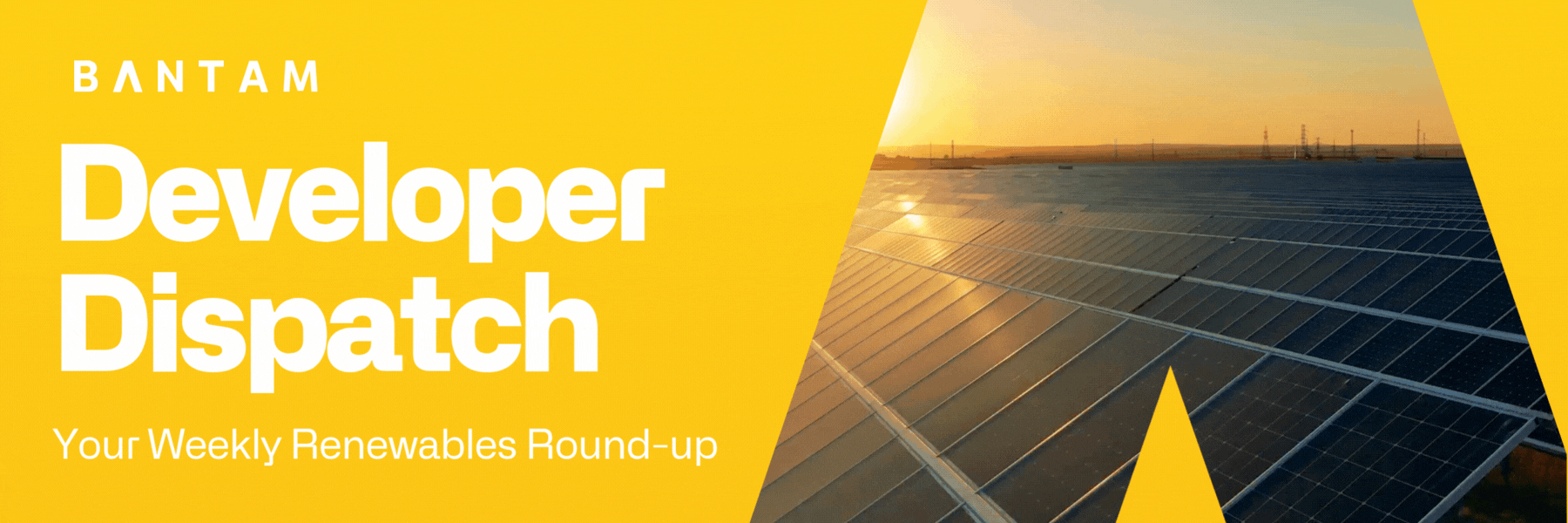|
|
 |
|
|
|
Good morning and happy Friday,
Tragic, deadly flooding in Texas has sharpened focus on the administration’s plans to cut funding for NOAA and the NWS, while also sparking renewed debate about geoengineering, a topic popular among conspiracy theorists.
Of course, the biggest news for renewable energy developers was the July 4th passage into law of President Trump’s One Big Beautiful Bill – we cover that in an extra in-depth in our “Must Read,” below. In a cabinet meeting Wednesday, the President made several false claims about wind energy, which AP helpfully fact checked.
The deregulation drive continues, with DOE on Monday issuing an interim final rule that rescinds all of its NEPA regulations and releasing “implementing procedures” to replace the previous regs. Meanwhile, after 300 EPA employees signed a letter declaring their opposition to the administration’s policies, 144 were placed on administrative leave and put under investigation.
And, a new report from Heatmap finds that a fifth of U.S. counties now restrict renewables development, a big jump from the previous estimate of “at least 15%” provided by USA Today in 2024.
On a sunnier note, in California solar has surpassed natural gas to become the biggest source of electricity.
Read on for more.
|
|
|
 |
|
|
Navigating the New Normal
Welp, it happened: the reconciliation bill was signed into law on July 4. Now what? Here’s a breakdown of key points you need to know:
Good News
-
Tax credit transferability lives on. Developers can still sell tax credits throughout a project’s operational life—a huge win for financing.
-
Storage, geothermal, hydro, and nuclear still count. These technologies stay eligible for clean energy credits (ITC/PTC) through 2033, phasing down in 2034 and ending after 2035.
-
A close call averted. Senate Republicans had added a surprise tax on renewables—but it was stripped out before final passage.
Bad News
-
Wind and solar timelines were slashed. Projects must either start construction by July 4, 2026 or achieve commercial operation by December 31, 2027 to qualify for tax credits.
-
Manufacturing incentives end early. Tax credits for wind components disappear after 2027. Credits for solar, battery, and critical mineral manufacturing phase down starting in 2031—and vanish entirely by 2034.
-
Foreign material restrictions get worse. Beginning in 2026, stricter rules will apply to projects that use inputs from “Foreign Entities of Concern” (like China), creating added complexity and investor risk.
The Executive Order
If the bill wasn’t enough, the President issued an executive order on Monday targeting “unreliable” energy sources like wind and solar.
-
Safe harbor rules just got shakier. The Treasury Department has 45 days to tighten rules on what qualifies as “beginning of construction.”
-
Projects will now need to show “substantial” physical progress—not just spend 5% on paper—to qualify for credits.
-
One expert warns: if enforced retroactively, this could blow up years of planning and billions in project pipeline investments.
-
Observers speculate the EO is the result of a deal Trump cut with the House Freedom Caucus – member Chip Roy (R-TX) said “We believe we’re going to get 90-plus percent of all future projects terminated.”
The Impacts
While the full effects will take time to materialize, early analyses point to meaningful changes in the trajectory of clean energy deployment:
-
Project timelines are tightening. Shorter eligibility windows and shifting guidance may make it harder for early-stage projects to stay on track. A near-term rush to qualify is likely, followed by a slower pace of new development as the market recalibrates.
-
81 GW of clean power capacity may not be built, according to Segue Sustainable Infrastructure.
-
$141 billion in anticipated clean energy investment could be withdrawn, also from Segue.
-
1.7 million jobs and $197 billion in wages are at risk, based on modeling from C2ES and Greenline Insights.
-
U.S. carbon emissions could rise by 8% by 2035, per the same model.
-
Wholesale power prices may increase by 74%, and GDP could see a cumulative $980 billion reduction, according to Energy Innovation.
⚡️ The Takeaway
The clean energy sector is recalibrating. Experts have condemned the bill as a major step backward—one remarked, “America didn’t have an energy emergency before, but this legislation goes a long way toward creating one.” With 1,290 days until a new administration takes office, the path forward will run through the states. Many governors and legislatures—red and blue alike—recognize the economic upside of clean energy and are already moving to safeguard it. That matters, especially given that most of the IRA’s funding and private-sector investments have landed in Republican districts. Federal headwinds are real, but momentum isn’t lost. Expect a surge in state-led strategies, coalition-building, and legislative action in the months ahead.
|
|
|
 |
|
|
Mapping the Pushback
Amidst the sturm und drang of the OBBB’s passage, Columbia’s Sabin Center released the fifth edition of its annual report, Opposition to Renewable Energy Facilities in the United States, which presents data from 2024, and found a 16% increase in local restrictions relative to the previous year. The data covers activity through the end of 2024 and shows a growing tide of restrictions and contested projects:
-
459 counties and municipalities across 44 states have enacted severe local siting restrictions—a 16% increase over the previous year.
-
498 renewable energy projects were contested in 49 states—up 32% from 2023.
-
There are currently 20 significant state-level restrictions across 16 states
-
The report emphasizes that raw numbers don’t tell the whole story: some states are overrepresented due to stronger local media coverage, and a high volume of contested projects doesn’t always mean siting is more difficult in practice.
⚡️ The Takeaway
Opposition report. In addition to their annual report, the Sabin Center has also launched a helpful new website, Opposition Report, which provides an interactive map of the U.S. showing state and local restrictions and contested projects. The site offers downloadable data files that include information about project type, status, capacity, and acreage, as well as dates relevant to restrictions or projects. As with the report, the map presents data through December 31, 2024.
|
|
|
 |
|
|
-
Steamed: GOP moderates balk at Trump renewables order
-
Fracked Up: DOE renewables pick offers mixed bag on solar, storage
-
Now What?: Where clean energy goes from here
-
No Bueno: U.S. Congress passes anti-clean energy budget bill: An industry reacts
-
Distilled: Navigating FEOC restrictions on energy projects and Navigating FEOC restrictions for the 45X energy manufacturing tax credit
-
Tax Expert: Utility-scale solar is not hit as bad as you think
-
Losing the Race: China's clean energy boom could win the race to power the future and China is building 74% of all current solar and wind projects, report says
-
Stranded Capital: The moment the clean-energy boom ran into ‘drill, baby, drill’
-
Effectively Useless: Anti-China rules make GOP megabill even worse for clean energy manufacturing
-
A Dizzying Amount of Wrangling: An inside look into the lobbying against clean energy
-
Sledgehammer: Trump’s ‘big, beautiful’ law tethers the US to the past
-
Crushing: Tax credit cuts in Trump’s megabill imperil two fully approved offshore wind farms
-
Cu Later: Copper cable thieves hit Scottish wind farms
-
What’s the Tariff On That?: Elon Musk confirms buying overseas power plant, shipping it to Memphis for xAI
-
Infocast Summit: Grid operators plan billions for transmission to meet load and connect renewables
-
Exploding Head Emoji: DOE reliability report warns renewables will add to '100% increased risk of power outages' by 2030; Texas begs to differ and Load growth, plant retirements could drive 100x increase in blackouts by 2030: DOE
-
A Bitter Divide: These fishermen made peace with offshore wind. Then Trump came along.
-
Swirling Headwinds: Geothermal survives in 'big, beautiful' budget bill – but hurdles remain
-
Sizzling Savings: A heat wave hit New England's grid. Clean energy saved the day.
-
AG Takes Aim: Missouri AG moves to kill $11B Grain Belt Express and A power line for clean energy was in the works. Now, an investigation looms.
-
A Fusion First: Google signs deal to buy fusion energy from Bill Gates-backed nuclear startup
-
Three Views: A rewrite of the Virginia Clean Economy Act seems increasingly likely and Five years in, the VCEA is paying off and Energy demands, regulations and federal funding challenge VCEA
-
Brain Power Sent Packing: Federal exodus imperils Trump’s permitting goals
-
Nope: N.C.’s Governor Stein vetoes bill that would have delayed clean energy goal
-
Mixed Bag: The ‘MAGA Solar Act’: Michigan Republicans’ solar playbook
-
Stunted: Trump's legislation will constrict the growth of Texas’ clean energy industry and its power grid
-
Monumental Target: Trump wants to expand nuclear power. It won’t be easy.
- Chart: 'Big, Beautiful Bill' will cause energy bills to go up in every state
|
|
|
 |
|
|
|
|
 |
|
|
One for the Record Books
Edmonton, Canada, has a few claims to fame – it was home for hockey legend Wayne Gretzky during his 9-year run with the Oilers, and it also boasts the largest mall in North America. Now it’s added another jewel to the crown: it hosts a building with the world’s largest solar panel mural, according to the Guiness Book of World Records.
The mosaic is installed on the SunRise building, a 12-story mixed use building. It uses building-integrated photovoltaics (BIPV) in the form of multicolored panels on all four sides of the building that complement and extend the building’s 85-foot-tall mural.
Named “The Land We Share,” the mural is a tribute to First Nations and Chinese cultures and was created by local Indigenous artist Lance Cardinal.
|
|
|
 |
|
|
|
The BIPVs were manufactured by Mitrex, which says the project will save the building about $80,000 annually in energy costs, achieving ROI in four years. Mitrex also makes solar PV bricks, railings, and noise barriers. The system installed on the SunRise is 267 kilowatts, enough to create around 180,000 kilowatt-hours of energy annually – about the amount of power needed for 23 homes. It’s nice to see sustainability being taken to new heights.
|
|
|
|
|
|
Thanks for diving into the Developer Dispatch with us.
|
|
|
|
|
|
|
|
|
|
Building American power requires a powerful team. |
|
|
|
|
|
|
|
|